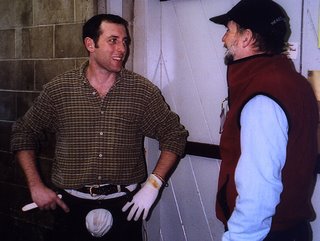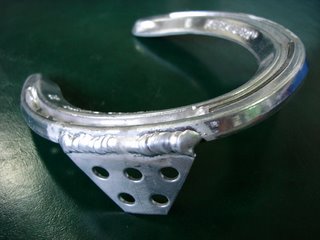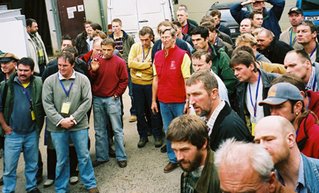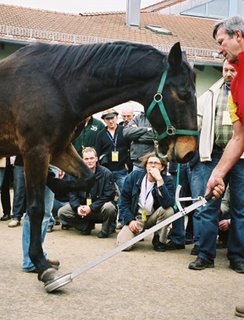
Patrick Reilly of Chester, New Hampshire will be changing his address on Monday, when he begins work as the new farrier at New Bolton Center, the site of the large animal clinics of the University of Pennsylvania's College of Veterinary Medicine.
To quote a memo from the administration: "(we) announce the appointment of Mr. Patrick (Pat) Reilly as Interim Director of the Farrier Service at New Bolton Center....thanks to Rob Sigafoos for helping to recruit Pat to New Bolton Center as we know Pat's work will compliment the excellence in the Farrier Program that has been established by Rob."
Rob's role at New Bolton is a little gray at the moment, since he is suffering from back problems but as far as I know, Rob has neither retired nor resigned, but is taking some time to recover.
Both Rob and Patrick will serve on the faculty of the 4th International Equine Conference on Laminitis and Diseases of the Foot in Palm Beach (aka "Palm Beach Laminitis") in November 2007.
Patrick has worked as consulting farrier at the New England Diagnostic Imaging Center (Myhre Equine Clinic) in Rochester, New Hampshire and also as a contract farrier for the Tufts Cummings School of Veterinary Medicine in North Grafton, Massachusetts. Until the hospital closed, he was consulting farrier at the Rochester Equine Clinic in New Hampshire.
Patrick is known for his expertise (and preference) for adhesive shoeing. I heard him say once at a conference that he had applied more than 300 pairs of glue-on shoes,primarily of the Sigafoos design, that year. He is also an early-adapter of technology, and was the farrier who taught me about Metron software. He has loaned me his laptop when mine was smoking from system overload. Patrick also has a fascination with biomechanics research; he actually reads all those charts and graphs, and has experimented with the interesting Tekscan pressure measuring system.
No word yet on whether Patrick will be working on New Bolton's most famous patient, Barbaro.
Please scroll down to posts from earlier in November or click here to read our "hail and farewell and hello again" to departing resident farrier at New Bolton, Laura Florence.
Good luck to Patrick! Get well to Rob!
Photo: Patrick Reilly (left) chats with Rob Sigafoos (right) at a recent conference. Fran Jurga photo, © Hoofcare & Lameness Journal.
All HoofBlog text and images © Hoofcare Publishing 2006 unless otherwise noted.
To learn more about new research, products, and treatments for the horse's hooves and legs as reported to veterinarians and farriers in the award-winning "Hoofcare & Lameness Journal", go to http://www.hoofcare.com
Direct link to subscribe via secure server to Hoofcare & Lameness Journal: http://www.hoofcare.com/subscribe.html
Save on books! Visit our "fall cleaning" sale of out-of-print, used, and damaged books: http://www.hoofcarebooksale.blogspot.com
Contact Hoofcare Publishing anytime: tel 978 281 3222 fax 978 283 8775 email bloginquiry@hoofcare.com
To learn more about new research, products, and treatments for the horse's hooves and legs as reported to veterinarians and farriers in the award-winning "Hoofcare & Lameness Journal", go to http://www.hoofcare.com
Direct link to subscribe via secure server to Hoofcare & Lameness Journal: http://www.hoofcare.com/subscribe.html
Save on books! Visit our "fall cleaning" sale of out-of-print, used, and damaged books: http://www.hoofcarebooksale.blogspot.com
Contact Hoofcare Publishing anytime: tel 978 281 3222 fax 978 283 8775 email bloginquiry@hoofcare.com






